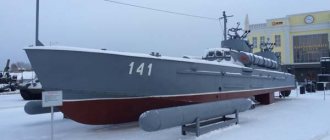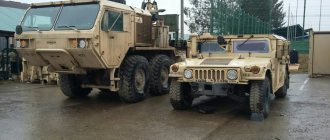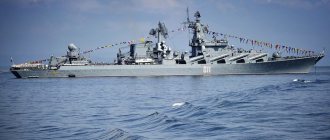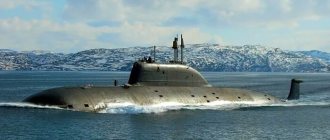In Soviet Union
In the USSR, submarines were used to transport goods and transport people during the defense of Sevastopol. In some cases, secret landings of sabotage and reconnaissance groups were carried out from submarines, often accompanied by difficulties and losses of personnel due to the unsuitability of submarines for solving problems of this kind. In 1948, the domestic TsKB-18 began to develop a preliminary design project 621
an amphibious transport submarine for the covert transportation of troops with military equipment and support.
The multi-hull boat with a displacement of about 5850 tons was intended to land 745 troops, 10 T-44 tanks, 3 La-5 aircraft, 14 guns and other cargo. It was planned to equip the boat with artillery weapons, rocket launchers to support landing forces and a catapult for launching aircraft. Several power plant options were considered, including a gas turbine unit. In 1952-1953. TsKB-18 also developed a preliminary design design for the 626
diesel-electric landing transport boat for operations in the Arctic seas. The boat, with a displacement of about 3,480 tons, was intended to transport 4 tanks, 165 troops or 330 tons of fuel. However, none of these projects were ever implemented[1].
On March 1, 1960, the Minister of Defense of the Soviet Union approved the technical specifications, and in September of the same year, four versions of the preliminary design of a “large nuclear transport-landing submarine - minelayer” were submitted for consideration by specialists of the Ministry of Defense.
Project 621
Immediately after the war, in 1948, the Project 621 submarine was proposed as a landing ship to transport troops behind enemy lines. With a displacement of 5,845 tons, the underwater giant would have been one of the largest submarines of its time. Due to significant comments and technical difficulties in implementation, the project was rejected by representatives of the Navy. The cargo transported included: 10 T-34 tanks, 12 trucks with 3 trailers, 4 passenger cars, 12 85 mm guns, 2 45 mm guns, 3 La-5 aircraft with folding wings, machine guns, mortars, machine guns, ammunition, fuel, provisions. The load also took into account the weight of 745 landing troops.
- Displacement: normal - 5845 t
- Length (according to the vertical line) - 147.5 m
- Width (maximum) - 13.3 m
- Average draft - 6.3 m
- Load capacity - 1550 t
- Immersion depth, maximum - 160 m
- Maximum surface speed - 15 knots
- Maximum underwater speed - 8.4 knots
- Autonomy - 70 days
- Autonomy of continuous stay under water - 600 hours
- Cruising range at 12 knot surface speed - 6000 miles
- Cruising range at 8.4 knots underwater speed - 4200 miles
- Cruising range at 3-knot underwater speed under batteries - 200 miles
- Power plant - 4 diesel engines with a total power of 8000 hp. s., 2 gas turbine units with a total capacity of 2730 l. s., 4 main electric motors with a total power of 7200 hp. p., 4 groups of rechargeable batteries of 112 cells in a group of type “46SU”, 4 screws
- Crew - 160 people
- Armament: 3 frames for rockets (ammunition - 360 missiles per frame); 2×2 57 mm ZAU SM-24-ZIF; 1×2 25 mm ZAU 2M-8
Project 664
The Project 664 nuclear-powered ship was created at TsKB-16 under the leadership of chief designer N. Kiselyov. The armament consisted of six TAs with a caliber of 533 mm, up to 162 mines RM-1, APM, and Serpey. As a supply ship, the nuclear submarine could transport and transfer up to 20 P-5 or P-6 cruise missiles. Construction of at least one Project 664 boat began in Severodvinsk in 1964, but the Navy's need for nuclear-powered missile carriers led to the cessation of work[2].
Project 748
At the end of the 1960s, there was another proposal - Project 748. This three-hulled submarine was theoretically capable of carrying up to 3 PT-76 amphibious tanks along with two BTR-60P armored personnel carriers, six company mortars and up to 470 soldiers [3]. The submarine was to be equipped with a torpedo armament consisting of four 21 inch (533 mm) torpedo tubes (from 18 to 20 torpedoes in reserve), as well as surface-to-air anti-aircraft guns and air defense systems. The preliminary design presented to the customer was not approved.
Project 717
By 1970, the Volna Central Design Bureau had developed a project for a multi-purpose mine-transport-landing submarine of Project 717, taking into account the experience of designing the Project 748 boat. The boat had a surface displacement of 18,000 tons with a length of 190 m. The ship was supposed to be nuclear powered, had a three-hull design and a shallow draft with a large width; it was supposed to be built at Sevmash, but due to the priority of other projects and limited slipway capacity, construction was never started.
The ideas proposed during these projects helped in the creation of projects for transport nuclear submarines, which were proposed by the Rubin Central Design Bureau in 1990[4].
Project representatives
Table colors:
| written off or scrapped |
| no exact data |
| in service |
| Page No. | Year of construction | CVD | Name | Postscript | Owner | Note |
| 28 | OK-1073 | KSF | Experimental boat | |||
| 34 | 1970 | Azov shipyard | Bryanka | Ochakov | Ukrainian Navy | former D-455 (w/n 538) from the KChF, transferred to the Navy on 04/15/1992, from 01/10/1996 - “Tarpan”, from 10/07/1998 - “Bryanka” (w/n U431)[2], in reserve since 2013 |
| 63 | LST-63 | built for the Ethiopian Navy in 1984, after May 1991 transferred to the Eritrean Navy, under tactical number LST-63[3] | ||||
| 64 | LST-64 | built for the Ethiopian Navy in 1984, after May 1991 transferred to the Eritrean Navy, under tactical number LST-64[3] | ||||
| 403 | 1969 | Khabarovsk Shipyard | BSS-224050 | KTOF | decommissioned in 2006 | |
| 409 | 1969 | Khabarovsk Shipyard | BSS-222050 | KTOF | ||
| 1969 | Khabarovsk Shipyard | Khabarovsk | Artel of prospectors "Vostok-1" | former ST-1510, transferred from the Pacific Fleet | ||
| 414 | 1969 | Khabarovsk Shipyard | East | Zeya | Artel of prospectors "Vostok-1" | former ST-3828, transferred 04/23/2002 |
| 419 | Khabarovsk Shipyard | BOHR | Amur Flotilla, decommissioned in 1998 | |||
| 425 | Khabarovsk Shipyard | BOHR | Amur Flotilla, decommissioned in 1998 | |||
| 718 | 1966 | CCZ No. 344 “Kama” | Monastyrsky-3 | Saint Petersburg | Valaam Monastery | transferred from the DKBF of the USSR Navy on April 20, 1990 to the Spaso-Preobrazhensky Valaam Stavropegic Monastery |
| 1966 | CCZ No. 344 “Kama” | Monastyrsky-1 | Saint Petersburg | Valaam Monastery | transferred from the DKBF of the USSR Navy on April 20, 1990 to the Spaso-Preobrazhensky Valaam Stavropegic Monastery | |
| D-437 | Zykh | Azerbaijan Navy | former D-603 (b/n 659) from KKFL, transferred in 1992 | |||
| D-438 | Zykh | Azerbaijan Navy | ||||
| 1970 | BSS-223050 | KTOF | ||||
| BSS-522050 | KTOF | expelled from the fleet in 2010 | ||||
| BSS-590050 | DKBF | |||||
| BSS-810050 | KTOF | |||||
| 1966 | D-136 | DKBF | decommissioned in 1990 | |||
| 1966 | D-153 | KKFL | decommissioned in 1992 | |||
| 1970 | D-231 | DKBF | ||||
| 1967 | D-319 | KTOF | decommissioned in 1996 | |||
| 1970 | D-332 | KTOF | decommissioned in 1996 | |||
| 1969 | D-343 | KTOF | tail number 679, from 06/30/1993 reclassified to BSS | |||
| 1970 | D-403 | KKFL | decommissioned in 1994 | |||
| 1970 | D-445 | KChF | decommissioned 22 August 1993 | |||
| 1970 | D-512 | KTOF | tail number 692, from 06/30/1993 reclassified to BSS | |||
| 1963 | D-514 | KKFL | decommissioned in 1990 | |||
| D-516 | KChF | D-516 transferred 12.1975 “object 805” | ||||
| D-530 | KChF | scrapped | ||||
| 1965 | D-534 | KKFL | decommissioned in 1992 | |||
| 1970 | D-536 | KTOF | tail number 682, from 06/30/1993 reclassified to BSS | |||
| D-537 | KChF | Decommissioned | ||||
| D-541 | KChF | abandoned, listed in reserve | ||||
| D-553 | KChF | decommissioned in 1993 | ||||
| 1969 | D-572 | KTOF | decommissioned in 1996 | |||
| D-580 | KChF | D-580 transferred 12.1972 “object 505” | ||||
| 1965 | D-596 | KKFL | decommissioned in 1993 | |||
| D-600 | KChF | D-600 transferred 12.1975 “object 805” | ||||
| D-601 | KChF | D-601 transferred 12.1975 “object 805” | ||||
| D-602 | KChF | Decommissioned | ||||
| D-642 | KKFL | |||||
| OK-1405 | Experimental boat | |||||
| T-141 | KTOF | |||||
| T-178 | KTOF | |||||
| T-201 | KTOF | |||||
| former D-577 from the KChF, sold to Cuba in August 1974 | ||||||
| former D-579 from the KChF, sold to Cuba in August 1974 | ||||||
| former D-160 from the KChF, sold to the Ethiopian Navy in December 1975, withdrawn from the fleet in 1991 | ||||||
| former D-171 from the KChF, sold to the Ethiopian Navy in December 1975, withdrawn from the fleet in 1991 | ||||||
| former D-151 (no. 564) from the KChF, in May 1979 sold to the Ethiopian Navy, withdrawn from the fleet in 1991 | ||||||
| former D-152 from the KChF, sold to the Ethiopian Navy in 1981, withdrawn from the fleet in 1991 | ||||||
| 1966 | former D-134 from the DKBF, sold to the South Yemen Navy in December 1981 | |||||
| 1966 | former D-135 from the DKBF, sold to the South Yemen Navy in December 1981 | |||||
| former BSS-197050 from the DKBF, in April 1992 transferred to the Estonian | ||||||
| 1969 | Azov shipyard | Sladak | Arkhangelsk | Ecotek-Bunker LLC | former D-??? from KSF, sold to Ecotek-Bunker LLC |
- In the 1970s, 6 boats of this type joined the Black Sea Fleet. Two of them were transferred to the Ukrainian Navy in the early 1990s.
- From the Pacific Fleet, 1 DKA (built in 1969) was transferred to the Municipal Unitary Enterprise "Gorvodokanal" of the city of Khabarovsk, new name "Budur"
- GT-908 (SSZ Hub, 1969 onboard A-310) from the 9th expeditionary detachment of underwater technical work was transferred to FGU Podvodrechstroy-9 in 1992, cut up/disposed of in the 2000s.
Export
About 60 landing boats were exported
- Algeria: 1 unit
- Angola: 5 units delivered in 1976
- Vietnam: 27 units delivered in 1979
- Guinea: In July 1974, 30 units
- Guinea-Bissau: In 1975 2 units, and in January 1979 2 units
- Kampuchea: In January 1985, 3 units (page no. 60, 61, 62)
- Cuba: In 1967 5 units, in August 1974 2 units (“D-577”, “D-579”).
- North Yemen: In 1971 2 units
- Somalia: In 1968 1 unit, in 1969 3 units[4] built by the Red Barricades Shipyard
- Ethiopia: In May 1979 “D-151”, in 1981 “D-152”, in December 1975 “D-160”, “D-171” in 1984 No. 63, No. 64 (after May 1991 2 units (No. 63, No. 64) Eritrean Navy - now LST-63, LST-64[3], two more went to Yemen at the same time, others were decommissioned)
- South Yemen: In November 1970, 3 units, in December 1981, 2 units from the Baltic Fleet (D-134, D-135)
Write-off
After decommissioning from the Navy, some boats were used as civilian vessels.
As a result of a storm on January 3, 1993, near the port of Novorossiysk at 8:15 am, several landing boats sank due to a pileup on top of each other. Including the D-530, which was transferred from the Poti naval base in December 1992. Later, the D-530 was raised and scrapped[5].
- ST-4121 (plant number 39) belonging to Kirovets LLP was burned on Sakhalin
- 19?? - PSKA-??? (b/n 743), D-537, D-602
- 1988 - 2 units belonging to North Yemen
- 1990 - D-136, D-514, plant No. 718 (now “Monastyrsky-3”)
- 1992 - D-153, D-534
- 1993 - D-553, D-445, D-596
- 1994 - D-403
- 1996 - D-319, D-332, D-572
- 1998 - serial number 419, serial number 425
- 2006 - BSS-224050
In the United States
| This section is missing references to information sources. Information must be verifiable, otherwise it may be questioned and deleted. You may edit this article to include links to authoritative sources. This mark was set on May 12, 2011 . |
The US Navy has also done some preliminary design work for underwater transport in the past, but the work did not go as far as in the USSR. In the 1950s, a design was proposed for a 10,000-ton submarine, 220 meters (720 ft) long and 38 meters (124 ft) wide. It was supposed to carry 2,240 marines, delivered ashore using some type of transport platform capable of moving at speeds of 100 mph (160 km/h).
Export
Georgia
2 units in 1992: MDK-01, 02 (former D-237, D-293)[1].
Ukraine
L434.
June 1, 2020 1 unit: Vil (until November 1, 1997 D-305), then raid dry cargo barge U763. Then returned to the class of landing boats, from 1998 U430, from 10/7/1998 “Svatovo” No. 537[1]. On June 1, 2020, after a major overhaul, it was returned to service with a new number L434.
North Yemen
2 units of project 1176E in 1983: No. 13, 14. Then as part of the fleet of the united Yemen[1].
Armament[ | ]
The boat's combat complex is a remote-controlled combat module developed by the Kalashnikov concern. The module has armor protection against 7.62 caliber bullets of the B-32 type and is gyro-stabilized along two axes, which increases shooting accuracy during rolling. Tracking of a moving target occurs automatically; the target tracking system has a memory function designed for 10 stationary targets[3]. Boats can use different combinations of interchangeable weapons[5]. The standard weapons include[2]:
- One 12.7mm machine gun or one 40mm grenade launcher on a swivel mount;
- Four 7.62mm machine guns, two per side;
- Four sea mines or a guided missile launcher.
The boats are also equipped with light unmanned aerial vehicles (reconnaissance vehicles) ZALA 421-16EM, which can transmit video in real time at a distance of up to 25 kilometers and in the dark[3].
From Ilion to the Dardanelles
Landing troops from the sea was invented in ancient times. Suffice it to recall the most publicized naval landing of all time - the operation of the 1st Achaean Corps to capture a bridgehead near the Troy fortified area.
Then everything was simpler: the shallow-draft ships of the ancient Greeks and other Vikings could not boast of outstanding carrying capacity and seaworthiness, but they could easily moor to any more or less suitable coast and land their “marines.”
But all good things come to an end someday.
The ships and their draft increased, and the disembarkation process became increasingly hemorrhoidal. Now it was necessary either to capture the port with its berths - which its owners often perceived without enthusiasm and did all sorts of mischief in the process, or to anchor at a safe depth, and then very slowly and sadly disembark using boats or even rafts.
The landing of French and British troops near Sevastopol during the Crimean War
Something needs to be done about this
This state of affairs lasted for more than half a thousand years, until the First World War, when troops began to land on a completely industrial scale. And only the failures of the “mistress of the seas” during the landing operation in the Dardanelles made us think about creating specialized landing craft. In England, this led to the introduction in 1915 of the Type X landing lighters, or “black bugs,” 135-ton self-propelled barges.
In Russia they took a different route.
In the same year, the Black Sea Fleet not only copied British lighters, but also came up with the famous “elpidifors” - specially built landing craft with a displacement of 1,300 tons. They could transport and, thanks to a special device, “directly” land up to 1000 soldiers ashore, plus provide them with artillery support. However, the Russian landing in the Bosphorus did not work out, so all the ships were eventually rebuilt into ships of other types.
British assault landing boats LCA (Landing Craft Assault) could take 36 fighters on board
A dozen years later, the British opted for small flat-bottomed troughs, equipped, like X-type lighters, with a folding ramp in the bow. In 1926, the “tank landing” boat MLC was developed for equipment up to ten tons, and in 1938, the “assault” LCA, transporting a platoon of infantry, was adopted. However, by the beginning of World War II, only nine units of the first type and 18 of the second were built in England. As they say - nothing to talk about.
Fortunately, in Germany this turned out to be even worse.
Only after breaking through to the English Channel in the summer of 1940 did the German generals finally begin to scratch their heads on the subject: “How are we actually going to cross this anti-tank ditch?” The result was the feverishly designed but highly successful 230-ton MFP fast landing barges and Siebel catamarans. These ships never reached England, but they spoiled a lot of our blood on the Black and Baltic Seas - and even on Ladoga. And the allies had to deal with them.
German high-speed landing barge MFP (Marinefährprahm) type D with a lifting capacity of up to 140 tons
Notes[ | ]
- ↑ 1 2 3
Landing boats “BK” (Russian)
(undefined)
. SeaTech. - ↑ 1 2
BK-16 (Russian)
(unspecified)
(inaccessible link). Euroyachting. Archived from the original on April 2, 2016. - ↑ 1 2 3
BK-16 in the period from June 16 to June 19, 2020 was presented at the open exhibition “Army-2015” in Kubinka near Moscow (Russian)
(undefined)
(inaccessible link). Euroyachting. Archived from the original on April 6, 2016. - ↑ 1 2 Karpenko A.V.
Special purpose combat boat BK-16 (Russian)
(unspecified)
. magazine "NEVSKY BASTION". - Battle group of landing boats from "Kalashnikov" (unspecified)
. Military-industrial courier (07/01/2015).









